Negev Pottery
"Negev ware" "Negevite ware"
"Negeb ware" "Negebite ware"
Crude, hand made pottery
(not Edomite pottery)
The disposable dinnerware of the ancient world.
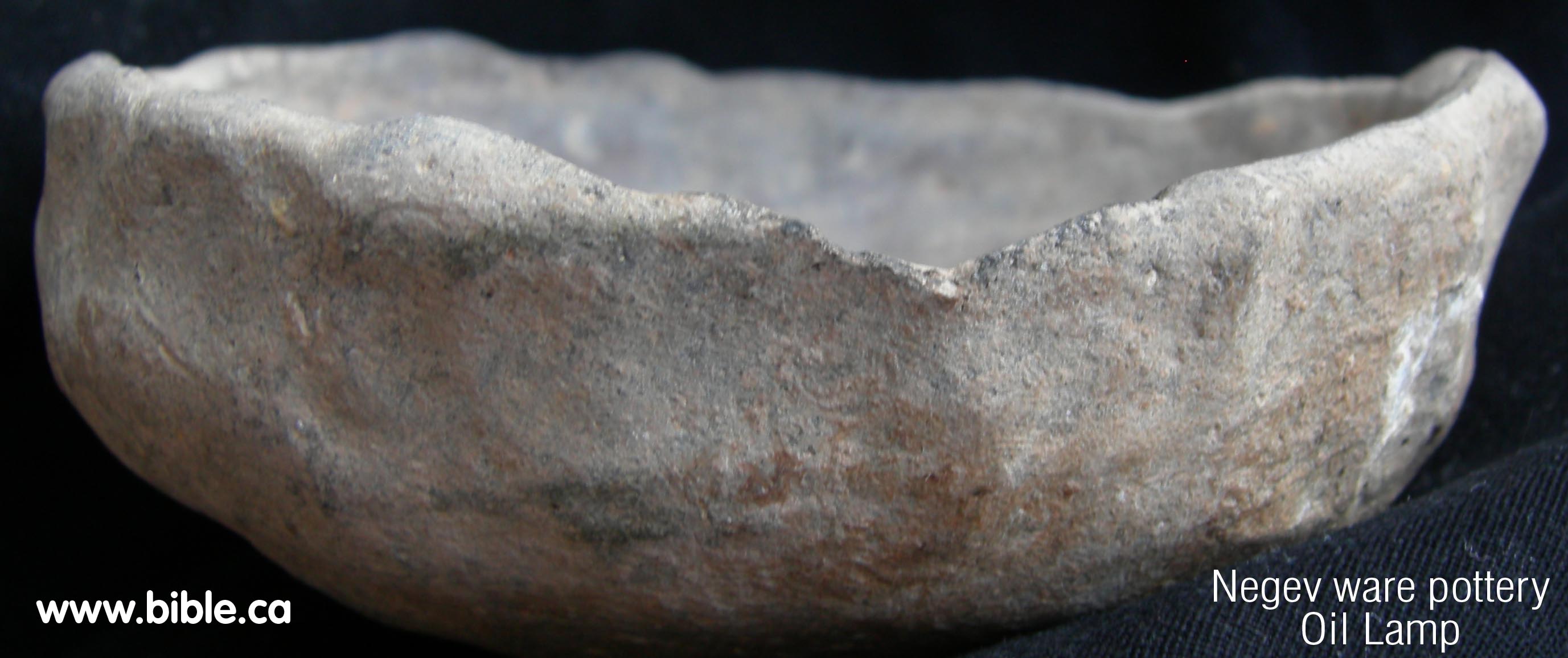
Pottery of the Bible
Introduction:
Negev ware pottery is hand made pottery from the Negev area of Israel from 1406 BC to 586 BC.
Negev Pottery is also found at Qudeirat and Timna and the Egyptian port island of Jezirat Faraun and Elat and Khirbat en-Nahas.
Negev pottery was the "disposable dinnerware" of the ancient world. It could be made easily by forming a dish out of clay to the shape of what you needed.
In network of military border fortresses in the Negev built by Solomon in 950 BC, it was most likely made by the male soldiers of Solomon while stationed at these various fortresses he built to protect and enforce the border between Israel and Egypt. There were some 50 fortresses in the Negev that Solomon built and there is a similarity in the types of pottery found at them all including Negev pottery. One exception was the fortress at Kuntillet Ajrud, which lacked Negev pottery.
"Surprisingly, the site yielded no "Negeb-type pottery" supposedly associated with the no-madic inhabitants of the area." (Kuntillet Ajrud, Ze'ev Meshel, Anchor Bible Dictionary, 1991 AD)
Although Negev pottery is found on a few homesteads, it is primarily found at either fortresses like Qudeirat or industrial areas like Timna. This leads us to conclude that Negev pottery was made by men as a quick type of "disposable" dinnerware.
Negev pottery is the disposable dinnerware of the ancient world made by men while away from home either as soldiers or miners.
"Another common denominator of the Negev fortresses besides the casemate structure, is Negev ware (Cohen 1986: 385-94). One may dispute its significance and the identity of the makers, but one cannot ignore the fact that Negev ware is a distinctly regional phenomenon, never appearing in the Beersheba Valley sites, whether early (Arad, Esdar, Beersheba, Masos) or late (Arocer, Ira, Uzza, Kitmit). I agree with the attribution of Negev ware to the southern desert nomads, and consider this quite adequate for our purpose." (The "Aharoni Fortress" Near Quseima and the "Israelite Fortresses" in the Negev, Zeev Meshel, 1994 AD)
A. The Handmade Pottery of the Negev
Negev ware was first discovered by Woolley and Lawrence in their two year excavation of Qudeirat. They also found it at Bir Birein.
Nelson Glueck also discovered Negev ware pottery in his excavations at Tell el-Kheleifeh in 1938-1940 AD. He wrongly assumed they were used for the smelting of copper from the mines at Timna.
It was made my hand and placed on a mat to dry. Human fingers can be seen to have shaped the pottery. The impressions of the mat can often be seen on the bottom of the pottery. It was fired on an open fire.
Some early archeologists mistakenly called Negev ware pottery, "Edomite pottery", which is a misnomer. This is a mistake. Don't insult the Edomites who were quite artistic and used a much "finer china" to eat and cook with. Further the Edomites never existed in the Negev until after the Babylonian captivity of 586 BC. Rather they lived exclusively transjordan until this time. So never call "Negev pottery", "Edomite pottery".
Negev ware pottery is also not what the Exodus Hebrews used. There is no evidence of this.
Cohen attributes the pottery to nomadic peoples: "The writer agrees that Negev ware properly should be associated with the wandering desert tribes and would further suggest that it be connected specifically with the Kenites, particularly in view of the fact that, in the Old Testament, a close relationship is posited between them and the Israelites (e.g., 1 Sam 15:6)" (Excavations At Kadesh-Barnea: 1976-1978, Ein el-Qudeirat, Rudolph Cohen, 1981 AD)
However it might be better associated with the Israelites who lived in remote areas of the Negev. The Hebrew women living in the Negev in 900 BC may have been very much like the women living in the western frontier of the USA 250 years ago. Living in isolation away from "civilization" may have required them to make their own dishes!
It is our opinion that Solomon's soldiers made Negev pottery while manning the forts of remote locations like Qudeirat. We must keep in mind that Negev pottery is found at fortresses that Solomon built in 950 BC. These were military installations to protect and enforce the ancient border with Egypt. Perhaps there was a lack of women, as garrisons of men would do a "tour of duty" away from their wives who lived closer to Jerusalem. This crude, hand-made pottery was the work of soldiers! Had women been present, surely they would have demanded a more chic and stylish decor for the kitchen, but men care for the food, not the dish they eat it out of. Negev pottery was fast and cheap to make. Who cares about designs when the only one's around to impress are other men? Awe to have a good woman around to make both the dinnerware and the dinner!
B. Archeological Dating and Negev ware pottery:
Negev pottery was used from as early as 1500 BC down to 586 AD.
Although some later pottery had some decorations on the rim, it is difficult to use this as a precise dating tool.
Archeologists generally agree that Negev pottery cannot, by itself be used for precise dating as wheel made pottery can be.
In Nelson Glueck's excavations at Tell el-Kheleifeh in 1938-1940 AD, he threw out much of the wheel made pottery, which is needed for dating and kept the Negev pottery which cannot be dated without the wheel make pottery. The wheel made pottery is forever lost because of his misunderstanding that Negev ware pottery was dateable.
Rudolph Cohen said this in 1981 AD in regards to his excavations at Qudeirat: "Negev ware cannot be used for chronological purposes but rather has to be dated itself on the basis of the wheel-made pottery found together with it. It was customary previously to assign it to the 10th century B.C.E., especially after the excavations at Ramat Matred (Aharoni et al. 1960: 97-111). However. B. Rothenberg's research in the Timna-Eilat area has shown that its origins may be several centuries earlier (1972: 153-54), and now, since the excavations at Kadesh-barnea, it is clear that it remained in use until the end of the Iron Age. Within this rather long time span, Negev ware appears to have undergone some changes. In the earlier levels (10th century B.C.E.) at Kadesh-barnea and elsewhere, virtually the only forms are cooking-pots and hole-mouth jars. By the time of the middle fortress (8th-7th centuries B.C.E.), however, a wide variety of forms were in use, many of them quite clearly modeled on contemporary wheel-made types. The Negev vessels found in this level at Kadesh-barnea include the common cooking-pots and hole-mouth jars, but also bowls and cups of different sizes (with and without handles), and a small chalice. The workmanship remains characteristically crude, but decorative indentation is sometimes added around the rim. As previously noted, these handmade vessels predominate among the pottery finds of the earlier two fortresses, but their representation declines, in proportion to the wheel-made ware, in the final fortress. Nevertheless, this upper level yields some interesting types, such as three oil-lamps and the incense-burner. The writer agrees that Negev ware properly should be associated with the wandering desert tribes and would further suggest that it be connected specifically with the Kenites, particularly in view of the fact that, in the Old Testament, a close relationship is posited between them and the Israelites (e.g., 1 Sam 15:6; see discussion in Fensham 1964: 51-54). (Excavations At Kadesh-Barnea: 1976-1978, Ein el-Qudeirat, Rudolph Cohen, 1981 AD)
Rothenberg is way off on a number of things. First he rejects the Bible's date for the Exodus of 1446 BC and believes it took place in 1270 BC. Second he then uses Negev Pottery as proof the fortresses predated Israel, since Negev ware pottery is found in most of the forts. The dilemma is solved if he had just read his Bible and learned the Exodus was in 1446 BC he would never had made the comments that the fortresses of the Negev could NOT be of Israelite origin. Rothenberg makes his final blunder in suggesting that Hezekiah wiped out the Amalekites in the Negev based upon 1 Chronicles 4:42-43: "From them, from the sons of Simeon, five hundred men went to Mount Seir, with Pelatiah, Neariah, Rephaiah and Uzziel, the sons of Ishi, as their leaders. They destroyed the remnant of the Amalekites who escaped, and have lived there to this day." Mt. Seir is transjordan and is not even located in the Negev! It is the capital of Edom. Poor Rothenberg. If only he had trusted the Bible much of his conclusions would have been truth and reality.
"The peculiar pottery-making tradition in the Negev, which could not possibly have originated in Judean times and never occurs anywhere in Judah itself, would therefore exclude any possible identification of the Negev settlements as Israelite. Although not enough archaeological evidence exists so far for the accurate dating of these settlements, the Timna Temple finds strongly corroborate the view that many of the agricultural settlements and hill fortresses in the Central Negev predate the Israelite conquest of Palestine and already existed as fortified Amalekite villages at the time of the Exodus. It therefore seems plausible to conclude that some of the battles between the Israelite tribes on their way to the Promised Land and the Amalekites, their arch enemies, must have taken place around these settlements and fortresses. It appears also most likely that the destruction of many of the fortresses and settlements was actually caused by the continuous struggle carried on during most of the Kingdom of Israel between Amalekites and Israelites. Amalekites were still reported as settlers in the Negev Mountains as late as the time of Hezekiah, King of Judah. In 1 Chronicles 4:42-43 we find the latest date for Amalekite habitation in the Negev given as the end of the eighth century BC, whilst the Negev-type pottery found in the Timna Temple strongly suggests the existence of a sedentary civilization in the Central Negev at the end of the fourteenth and continuing well into the twelfth centuries BC." (Timna, Beno Rothenberg, 1969 AD)
"Rothenberg's dating is incompatible with the Iron Age wheel-made pottery found in these sites (most of which, we should point out, came to light after the publication of Rothenberg's study." (Enclosed Settlements in the Negeb, Ze'ev Herzog, 1983 AD)
"Two of Rothenberg's basic arguments-namely that the Negev fortresses were actually agricultural settlements and that they were founded not as royal enterprises but by the semi-nomadic bearers of the Negev ware-were adopted by Etam in a short response to Cohen's Hebrew version of his summarizing article on the Negev fortresses (Cohen 1979; Etam 1980). But, unlike Rothenberg, Etam dates this settlement to the 11 th century B.C. and attributes the entire network of sites in the Negev highlands to an autochthonous population (he clearly avoids naming this population in more specific ethnic terms) that used this Negev ware. The termination of habitation was, according to Etam, caused by Saul, who destroyed the city of Amalek. Before considering this theory, I must point out a fundamental contradiction in Etam's hypothesis: he tries to prove that the settlements were not of defensive character, while at the same time he denies their attribution to Saul on the grounds that it is difficult to imagine that this king built defensive systems to fortify the southern border of the kingdom while it was still in its infancy." (Enclosed Settlements in the Negeb, Ze'ev Herzog, 1983 AD)
C. Negev ware Oil lamp: 1000 BC
|
Steve Rudd collected this piece in Israel in 2007. It is an oil lamp. The bowl would be filled with olive oil and a wick would be placed from the center of the bottom running up the side to the spout. You can see where the flame was by the darkened section at the top of the photograph. |
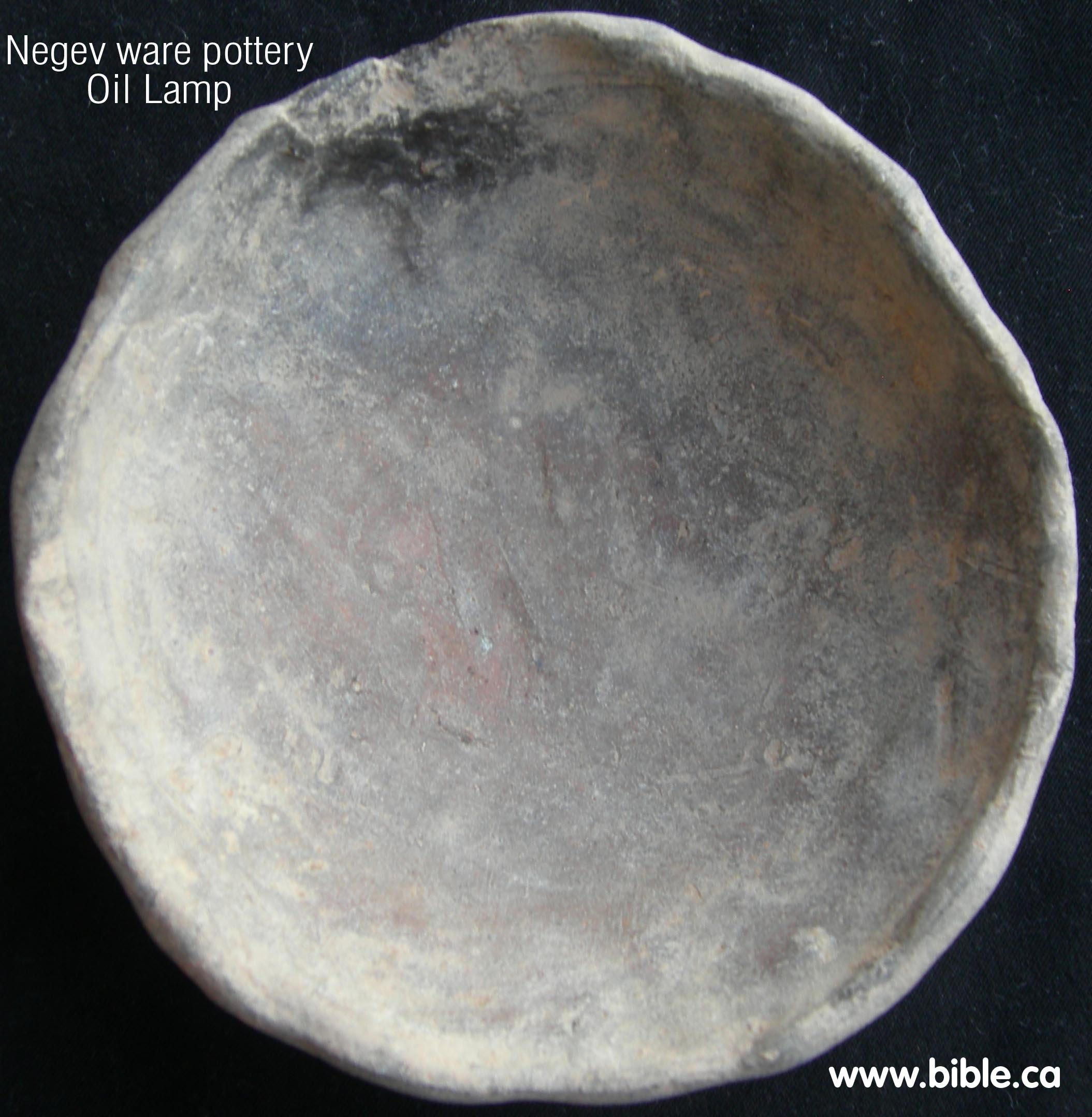
|
|
Here is side view of the spout where the wick would lay against the edge. The spout was the lowest point of the rim and allowed the wick to sit in place. |

|
|
Here is side view of the spout where the wick would lay against the edge. The blackened area is still clearly visible. |
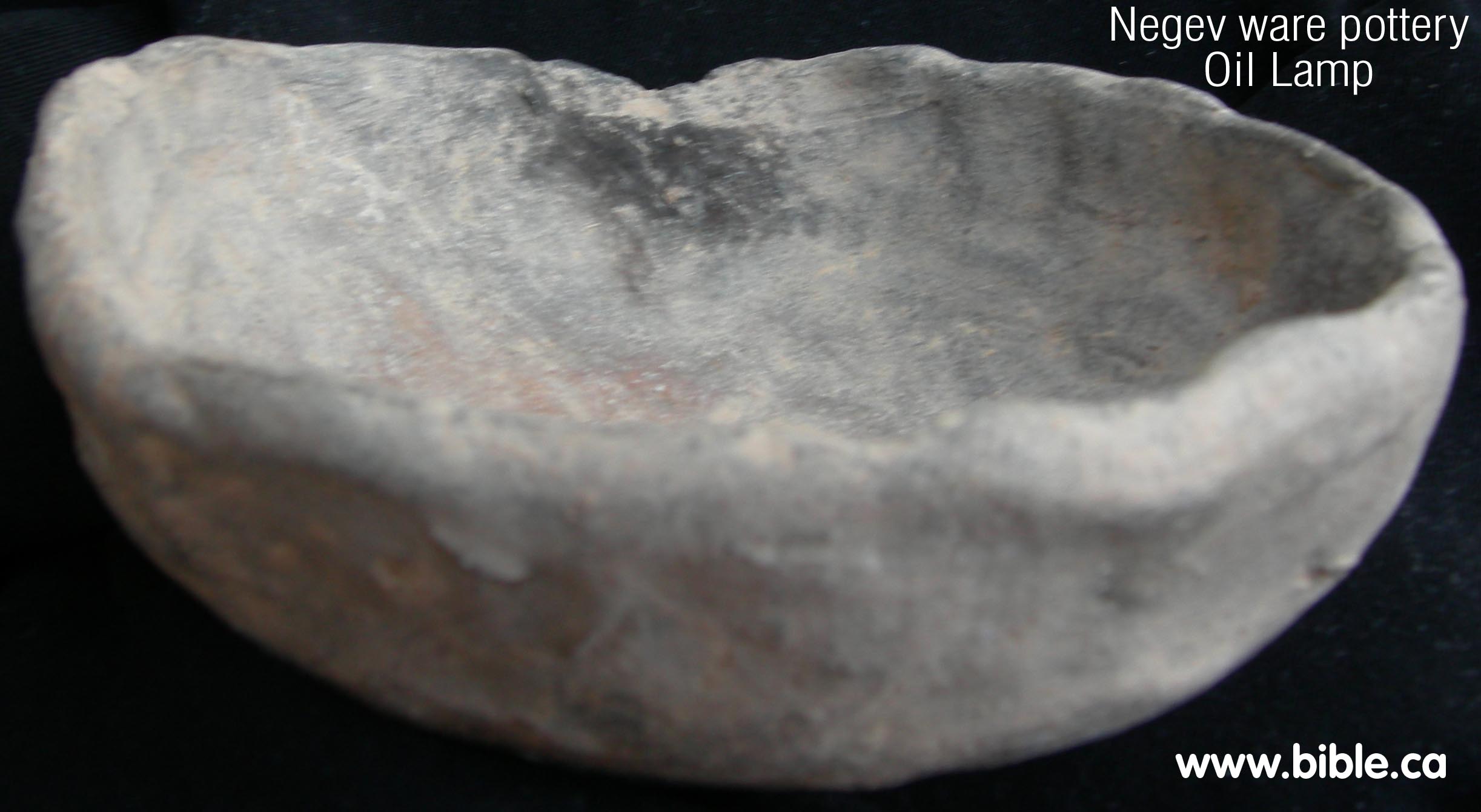
|
|
Negev ware was hand made and place on mats. You can still see the lines of the mat that it sat upon as the clay dried before firing. Notice also the finger marks from being hand formed. |
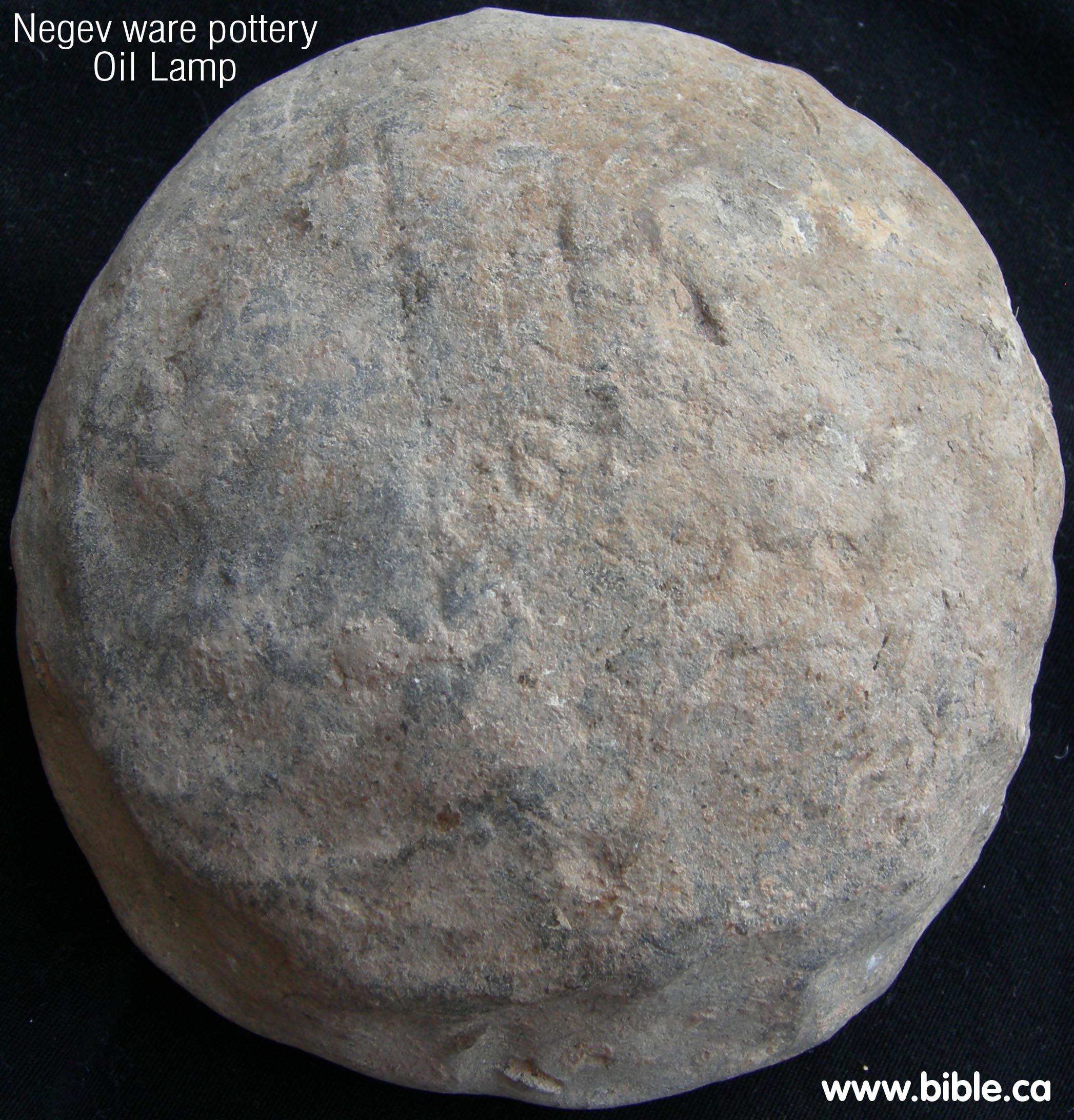
|
|
Being hand make, the finger marks are highly visible. |
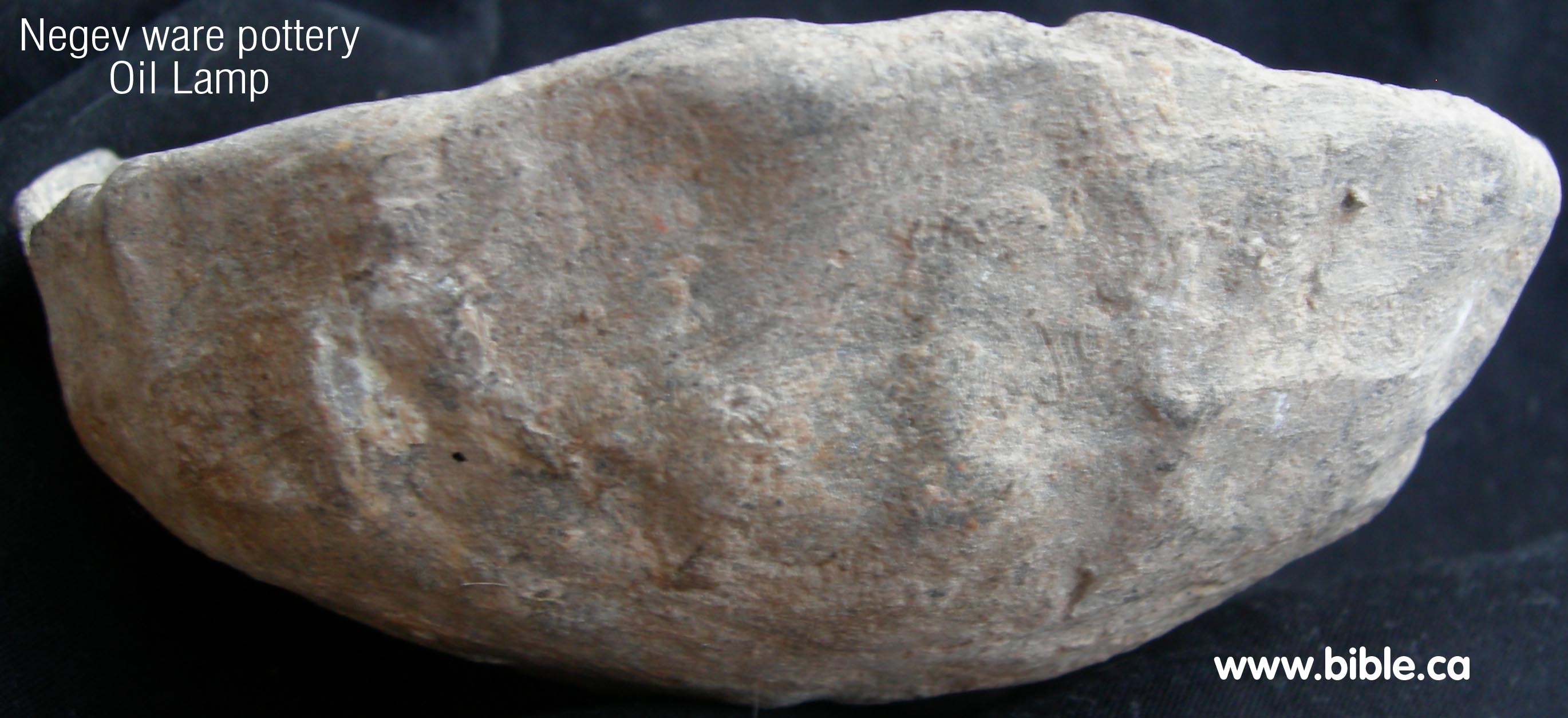
|
Solomon's network of military border fortresses in the Negev
D. Negev ware found at Qudeirat
Qudeirat is wrongly marked on almost all Bible maps today as Kadesh Barnea.
At Qudeirat is one of Solomon's fortresses he built in 950 BC. There were three distinct occupation periods at Qudeirat.
"Both wheel-made and handmade vessels were recovered from each of the fortresses. The wheel-made pottery, as described above, belongs to different assemblages, defined according to period, already familiar from Judean sites further north. In fact, it is mainly on the basis of ceramic typology—utilizing the wheel-made wares of the Iron Age—that the three successive fortresses have been dated. The handmade vessels, by contrast, are specific to sites in the Negev, and the last four seasons of excavations at Kadesh-barnea have produced both new types and insights." (Excavations At Kadesh-Barnea: 1976-1978, Ein el-Qudeirat, Rudolph Cohen, 1981 AD)
""Negev" pottery cannot be used for dating purposes. On the contrary, it must be dated on the basis of wheel-made pottery found with it. The earliest Negev pottery has been dated in this way to about the 13th or 12th century B.C., the period of the Exodus. [note: the exodus took place in 1446 BC, not 1270 BC as Cohen wrongly believes.] Our excavations at Kadesh-Barnea indicate that Negev ware continued to be produced until the end of the Iron Age—that is, until the destruction of the First Temple in 587 B.C. The Negev ware found at Kadesh-Barnea included cooking pots, kraters, cups, and bowls of various kinds, some with knobs or ledge-handles, which seem to imitate wheel-made bowls from elsewhere in the country. Among the more unusual items, which have expanded the corpus of known "Negev" types, are three oil lamps, a small chalice and the incense burner, referred to above. These more experimental forms are associated primarily with the later levels of the site." (Did I Excavate Kadesh-Barnea? absence of Exodus remains poses problem, Rudolph Cohen)
The percentage mix of Negev pottery increases as you dig to lower, older levels at Qudeirat. At the oldest level, dated from 950 BC, there is a lot more Negev pottery found than at the youngest level of 586 BC.
"Interestingly, the proportion of handmade to wheel-made vessels was much higher in this earlier fortress than in the upper one. It is also apparent that this handmade pottery imitates wheel-made types." (Excavations At Kadesh-Barnea: 1976-1978, Ein el-Qudeirat, Rudolph Cohen, 1981 AD)
"Like the fortresses and fortified settlements of the Negev, the pottery of Tell el-Kheleifeh falls into two categories of manufacturing technique: the crude, handmade "Negevite" wares and several horizons of wheelmade pottery. Included among the wheelmade corpus are examples that belong to the so-called "Midianite," "Edomite," and "Assyrian" horizons. The former is represented by six sherds whose stratigraphic context is uncertain at best. Given the uncertainty of field provenance and the chronology of "Midianite" pottery, which can antedate the Tell el-Kheleifeh assemblage by some four centuries (Rothenberg and Glass 1981: 85-114; 1983: 100-1), these few sherds surely do not document an occupational horizon." (Excavations at Tell el-Kheleifeh: A Reappraisal, Gary D. Pratico, 1985 AD)
"Subsequently, however, similar handmade pottery began to appear at numerous other Iron Age sites, particularly in the Central Negev and Timna-Eilat area. Y. Aharoni, for instance, collected such sherds amid the remains of the farmsteads on Ramat Matred and related them to the seminomadic inhabitants of the desert: This latter [hand-made] pottery was no doubt made locally by the most primitive methods, i.e., on a mat and with very bad firing. It may be conjectured that these vessels were the work of nomad potters, who, being constantly on the move from settlement to settlement in the Negev and `Aravah, could not make use of the more highly developed instruments of their craft, such as the potter's wheel and a permanent clay oven. These simple and cheap utensils largely satisfied the daily needs of the local population, especially as cooking pots. At the same time, a certain amount of the usual pottery of the period was imported from further north (Aharoni et al. 1960: 101-2)." (Excavations At Kadesh-Barnea: 1976-1978, Ein el-Qudeirat, Rudolph Cohen, 1981 AD)
|
Bowl
700 BC
Qudeirat |
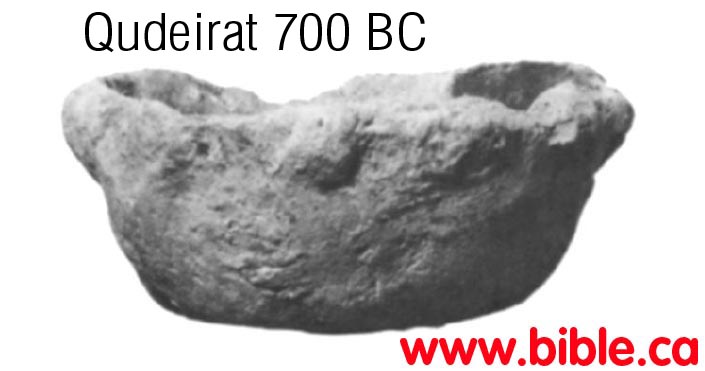
|
|
Astarte, "mother of heaven" bird god of fertility.
700 BC
Qudeirat |
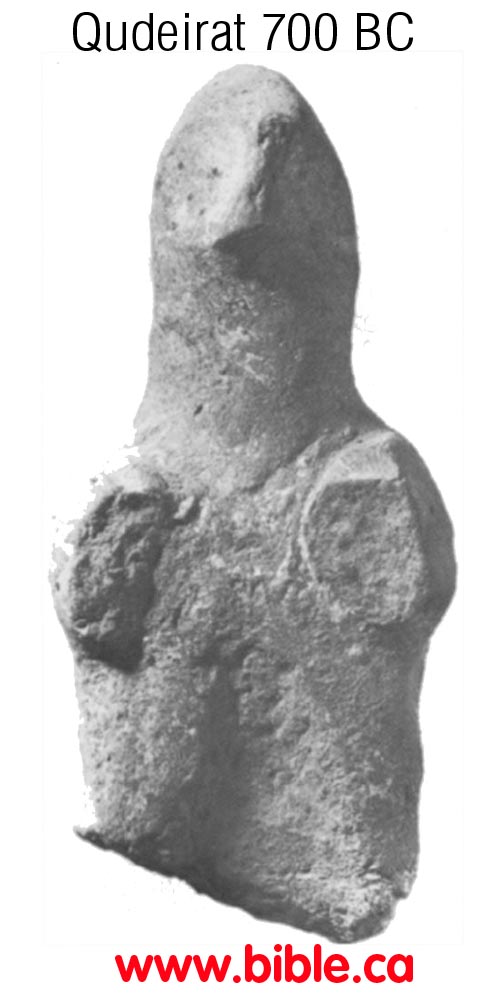
|
|
Bowl with artistic decoration on rim
800 BC
Qudeirat |
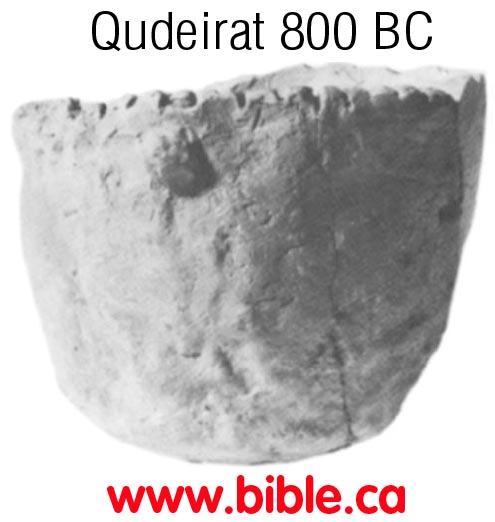
|
|
Qudeirat |
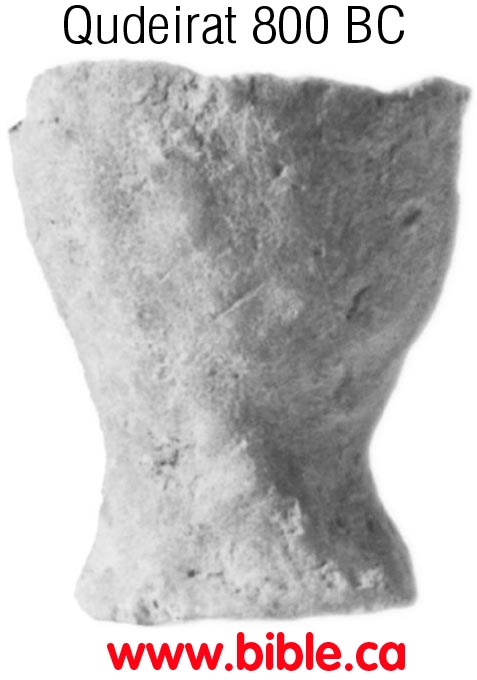
|
|
Oil lamps
800 BC
Qudeirat |
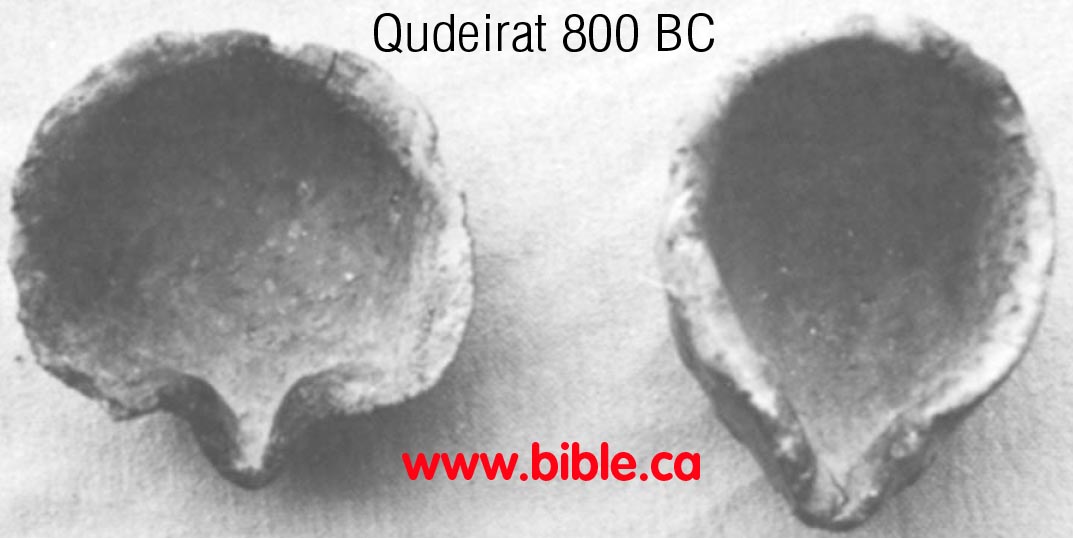
|
E. Negev pottery found at Ein Qedeis:
Qedeis is one of the fortresses built by Solomon in 950 BC. It was considered to be the location for Kadesh Barnea between 1881 and 1916 AD. In 1916, Qudeirat unfortunately became the universal choice for Kadesh down to the present time. Solomon's network of military border fortresses in the Negev
The remains of the pottery, found in the ash layer that covered the beaten-earth floor of the casemate rooms, are of two basic types: wheel-made pottery characteristic of the 10th century B.C., of which two entire juglets deserve to be specially mentioned; and hand-made pottery of the "Negev" type. One phase of occupation was detected in the fortress, but to the northwest of the hill are traces of a small settlement (Rothenberg 1967: pl. 46)." (The Iron Age Fortresses in the Central Negev, Rudolph Cohen, 1979 AD)G. Negev ware pottery found at Elat (Tell el-Kheleifeh)
- Negev pottery w
as found at Elat (Tell el-Kheleifeh). Tell el-Kheleifeh is identified as ancient Elat was actually built by Solomon in 950 BC as part of his border fortresses. Elat is clearly very near by, as is Ezion-Geber which is located under the modern shipping yards of Jordan.
- "Tell el-Kheleifeh might still fit the location of Eloth, although no pottery securely datable to the Solomonic period has yet been found there. (Unfortunately,
Glueck threw out most of the common wheel-made pottery he excavated; he did not realize this common wheel-made pottery was far more reliable for dating purposes than the handmade pottery he saved.)" (Jezirat Faraun: Is This Solomon's Seaport?, Alexander Flinder, 1989 AD)
- "It should be mentioned in this connection that both on the surface and in the excavations of Tell el-Kheleifeh a coarse, handmade type of pottery was found that at the time was new to us, and that for a brief while appeared to us to be utilized for crucibles. We soon abandoned this idea when it became apparent how common this pottery was on contemporary sites in the Negeb, as well as in the Wadi Arabah and at Tell el-Kheleifeh. Many of these crude, handmade vessels, with which appeared more familiar types of Iron I and early Iron II wheelmade wares, some of which seemed to have regional differences, had mat bases and knob or horn or ledge handles. We believe that this crude, handmade ware was largely the work of Kenites, Rechabites, Calebites, Yerahmeelites and related inhabitants of the Negeb and the Wadi Arabah and is characteristic of much of the pottery of Iron I-II in an area comprising the Negeb, Sinai, the Arabah, and much of Arabia. Tell el-Kheleifeh was obviously a central point of that area." (
Ezion-Geber, Nelson Glueck, Excavations at Tell el-Kheleifeh, 1965 AD)
- The pottery of Tell el-Qudeirat offers closer parallels to that of Tell el-Kheleifeh than any other site repertoire as a whole, although the fabrics are notably different. This is especially true for the "Negevite" pottery attested in the three phases at Tell el-Qudeirat (Cohen 1981: 101). The same range of "Negevite" types is attested at both sites. The Tell el-Kheleifeh wares are most closely paralleled, however, by the handmade and wheel-made pottery of Tell el-Qudeirat's middle and latest fortress phases, dated by the excavator between the 8th and early 6th centuries B.C. (
Excavations at Tell el-Kheleifeh: A Reappraisal, Gary D. Pratico, 1985 AD)
- Only a handful of "Negevite" straight-walled and "hole-mouth" cooking pots (cf. fig. 12: 1-5) can be associated with the earliest level. (
Excavations at Tell el-Kheleifeh: A Reappraisal, Gary D. Pratico, 1985 AD)
- Chronology of the Pottery: Reappraisal of the wheelmade pottery has suggested significant revisions in the site's chronological horizons. While acknowledging the presence of a few forms that can be dated earlier, the pottery must be assigned to the 8th-early 6th century B.C. (
Excavations at Tell el-Kheleifeh: A Reappraisal, Gary D. Pratico, 1985 AD)
- The largest pottery horizon in the Tell el-Kheleifeh repertoire is "Negevite" ware, accurately described when first discovered as "fragments of rough hand-made wares, thin-walled, of gritty clay burnt very hard in an open hearth" (Woolley and Lawrence 1914-15: 67). It was first thought by Glueck to be a diagnostic horizon of the 10th century B.C. Recent surveys and excavations have significantly refined the chronology and distribution of this pottery. It is surely attested throughout the Iron Age and perhaps even earlier and later (Rothenberg 1972: 153-54; Cohen 1981: 102). These wares have been found at numerous Iron Age sites, especially the fortresses and fortified settlements of the Negev. They include Horvat Haluqim (Cohen 1976: 34-50), 'Atar Haroca (Cohen 1970: 6-24), Horvat Ritma (Meshel 1977: 110-35), Tell el-Qudeirat (Cohen 1981: 98-103) and numerous lesser known sites (most accessible in Cohen 1979: 75-77). A few "Negevite" vessels have been excavated at the Jordanian site of Buseirah (Bennett 1975: fig. 6:8, 12). (
Excavations at Tell el-Kheleifeh: A Reappraisal, Gary D. Pratico, 1985 AD)
- At Tell el-Kheleifeh this handmade pottery is attested in both casemate fortress and fortified settlement levels. There is a fairly wide range of types, although straight-walled and holemouth cooking pots predominate. (
Excavations at Tell el-Kheleifeh: A Reappraisal, Gary D. Pratico, 1985 AD)
- The "Negevite" forms that can be assigned to the casemate fortress, provide no refined indication of chronology. The date of this level cannot be determined in light of current data. (
Excavations at Tell el-Kheleifeh: A Reappraisal, Gary D. Pratico, 1985 AD)
- Cohen (1979: 77-78) dates the wheelmade vessels exclusively to the 10th century B.C. and attributes the sites to the time of Solomon, (1979), whereas Meshel dates the pottery to the 1lth to 10th century B.C. and associates the fortresses with "one of the kings who defeated the Edomites and Amalekites" (Meshel and Cohen 1980: 80), either Saul or David. (
Excavations at Tell el-Kheleifeh: A Reappraisal, Gary D. Pratico, 1985 AD)
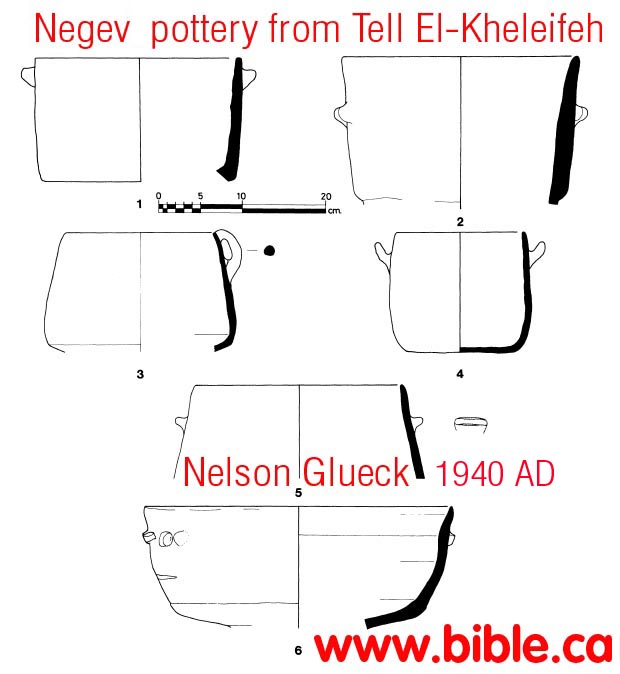
F. Negev pottery found Quseima:
Quseima is one of the fortresses built by Solomon in 950 BC. It was located at the most important crossroads in the Sinai. see: Solomon's network of military border fortresses in the Negev
The main finds, as stated, were potsherds. Not one complete or even restorable vessel was found. As usual in sites of this category in the Negev, the pottery was of two types: ordinary, wheel-made pottery, characteristic of the Iron Age; and rough, handmade pottery, of the type known as "Negev ware" (Cohen 1986). The number of Negev ware sherds was small. A selection of the ordinary vessels is shown in Figure 17. The pottery in general resembles that found in other fortress sites, as thoroughly demonstrated by Cohen (1986: 155-63). The bowl base, slipped on the outside and with band burnishing inside (figure 17:1), is similar to Cohen's figure 155.10. The cooking pot (figure 17:2) is a broad, low pot with carinated body; rounded base; two handles; and a broad, thickened lapped rim, either straight or slightly incurved. A few examples are illustrated(The "Aharoni Fortress" Near Quseima and the "Israelite Fortresses" in the Negev, Zeev Meshel, 1994 AD)
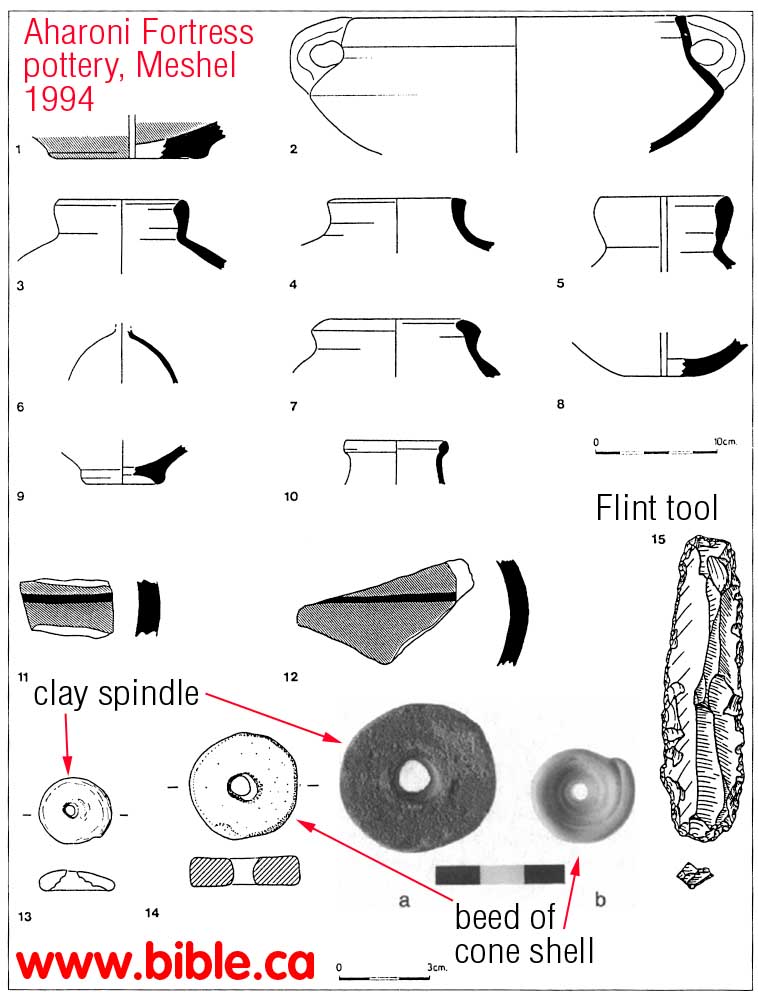
G. Negev pottery NOT found at Kuntillet Ajrud.
Kuntillet Ajrud is one of Solomon's network of military border fortresses in the Negev in 950 BC.
It underwent a secondary use after this.
"Surprisingly, the site yielded no "Negeb-type pottery" supposedly associated with the no-madic inhabitants of the area." (Kuntillet Ajrud, Ze'ev Meshel, Anchor Bible Dictionary, 1991 AD)
H. Negev ware pottery found Ein Haseva Fortress:
Haseva is one of Solomon's network of military border fortresses in the Negev in 950 BC.
"Diggers retrieved a complete handmade Negbite cooking-pot, made of rather coarse ware and exhibiting very crude manufacturing, from the southeastern room of this fortress. Negbite ware has been found at Tell el-Kheleifeh (Glueck 1939:13f; 1940:17f; Pratico 1985:23f) and in all three fortresses uncovered at Kadesh-Barnea (Cohen 1981;1983a), dating from the tenth to the beginning of the sixth centuries BCE." (The Iron Age Fortresses at En Haseva, Rudolph Cohen, 1995 AD)
I. Negev ware found at Timna:
Timna was one of two Egyptian mining centers under their complete control in 1446 BC. The exodus brought Israel into the Negev for the first time in 1446 BC. From 1446 - 1300 BC the Egyptians entered into a partnership with the Kenites. Eventually by 1200 BC the mines were closed and the Kenites took over control. In 950 BC Solomon exercised military control over the area although there is no proof he ever mined here.
Negev war pottery is found at Timna, but it differs in style from that found at Solomon's border fortresses. While both were hand made by men, the Negev ware at Timna dates 100-300 years earlier to as old as 1446 BC.
"All over Site 2, as at most sites in the Timna Valley, sherds of three distinct kinds were collected: 1. 'Normal' ordinary wheel-made pottery, plain but well-fired, consisting mainly of many-handled storage jars, carinated bowls, jugs and juglets. 2. Coarse, hand-made, deep as well as shallow bowls used for cooking and domestic purposes, akin to that previously found in the Central Negev Mountains, and named 'Negev-type ware'. Many of the flat bottoms of these bowls show mat-impressions. 3. Unique, pink-buff ware, decorated with bichrome geometrical designs (red-brown and black), made of well-levigated, evenly fired clay. Most of these sherds found at Site 2 belonged to large deep and shallow little bowls, with flat bottoms and straight sides, and having an occasional knob-handle projecting from the rim. There were also fragments of deep cups, decorated with bichrome `Union-Jacks' and similar geometrical decorations, and shallow bowls with a floral design in the centre. No pottery of this kind has ever been found in Palestine but it has been picked up on the surface of sites in Jordan, and had been named 'Edomite pottery'. Since there is evidence for a Midianite origin of this ware, it should now be called 'Midianite' pottery." (Timna, Beno Rothenberg, 1969 AD)
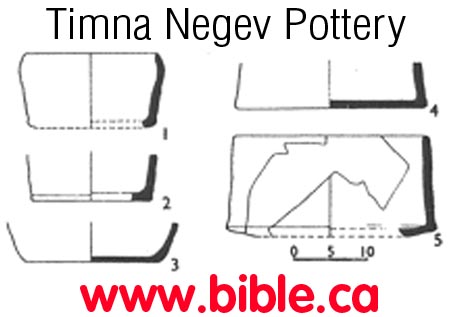 Timna provides insight into how Negev ware was made. Mat impressions are found on the bottom of the Negev ware at Timna:
Timna provides insight into how Negev ware was made. Mat impressions are found on the bottom of the Negev ware at Timna:
"A large quantity of sherds was found in the excavation of Site 2 and made the subject of a detailed study by Y. Aharoni. Compared with the rather meagre pottery from the surface collection, the excavation secured many additional types, including pieces important for dating. In all areas the same three kinds of pottery, collected on the surface during the previous surveys were found together on most of the different working floors and in many of the pits. The excavations proved, beyond a shadow of doubt, that these three distinct kinds of pottery - 'normal' wheel-made pottery, 'Negev-type' pottery and 'Midianite' pottery - were used in Timna at one and the same time. But, important as this conclusion may be from the stratigraphic, historical and ethnographic aspects of the excavations, none but the normal, wheel-made pottery could be of any real help for the dating of the site, because only comparative material for this kind of pottery was available. Luckily, quite a number of distinctive types were secured, including cooking pots of the shallow, open and carinated type, with small, folded, triangular-shaped rims and no handles. These pots closely resemble the typical Late Bronze Age cooking pots of Palestine and of the neighbouring countries. Many large carinated bowls with handles, and storage jars with pointed and thickened bases can also be dated to Late Bronze Age-Early Iron Age tradition. Two pithoi with collared rims are of a highly indicative type very common in the Early Iron Age of Palestine. Other typical types of Late Bronze Age date are jugs with pinched or rounded mouths, a pyxis, and some fragments of deep lamps with small rims and rounded bases. Only few details were added by the excavations to the repertory of the Negev ware, including some small cups and bowls with inverted rims and rounded bases, some round-based cooking pots and several vessels with fabric impressions not only on their bases but also on their sides. This latter detail clearly shows an additional method of primitive pottery manufacture in Timna. Conclusive evidence for the origin in Timna of at least part of the Negev-type ware found in the excavation, can be seen in the copper slag fragments included as temper in the clay of many of these cooking pots." (Timna, Beno Rothenberg, 1969 AD)
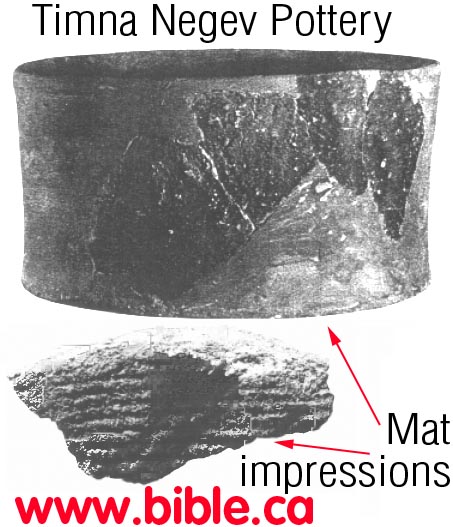 At the Egyptian pagan temple of Hathor, they found Negev Pottery:
At the Egyptian pagan temple of Hathor, they found Negev Pottery:
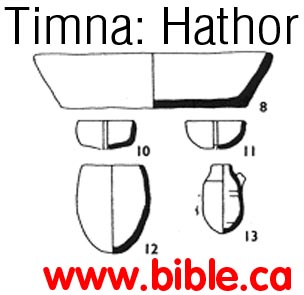 "The absolute dates now available for the three kinds of pottery found in the temple help us to date many important sites in the Central Negev and the Arabah, in Edom and especially in 'the Land of Midian'. In the Central Negev, in the area south of the Jeruham valley and north of the Makhtesh Ramon, there existed numerous settlements based on dry farming in terraced wadi beds and the use of cisterns and run-off rain water for irrigation. These settlements and the casemate fortlets attached were generally identified as `Israelite settlements' because Iron Age pottery was found amongst the ruins, including much of the unique primitive, hand-made, Negev-type pottery. Biblical associations rather than stratified archaeological evidence seem to have led to the dating of these settlements to the tenth to eighth centuries BC and their relation to the Judaean Kingdom. Continuous study of these settlements, their unique irrigation technology and pottery, had related the sedentary civilization of the Negev to the Amalekite tribes, mentioned in the Bible as the inhabitants of the Negev Mountains at least as early as the thirteenth century and down to the eighth century BC. Yet, the fact that in many of these settlements only Negev-type pottery was found, made the dating rather uncertain. Now, with the discovery of the Timna Temple, we have indisputable evidence that Negev-type pottery was made as early as the late fourteenth century BC and was in use for a very long period afterwards. The peculiar pottery-making tradition in the Negev, which could not possibly have originated in Judaean times and never occurs anywhere in Judah itself, would therefore exclude any possible identification of the Negev settlements as Israelite. Although not enough archaeological evidence exists so far for the accurate dating of these settlements, the Timna Temple finds strongly corroborate the view that many of the agricultural settlements and hill fortresses in the Central Negev predate the Israelite conquest of Palestine and already existed as fortified Amalekite villages at the time of the ExiNius. It therefore seems plausible to conclude that some of the battles between the Israelite tribes on their way to the Promised Land and the Amalekites, their arch enemies, must have taken place around these settlements and fortresses. It appears also most likely that the destruction of many of the fortresses and settlements was actually caused by the continuous struggle carried on during most of the Kingdom of Israel between Amalekites and Israelites. Amalekites were still reported as settlers in the Negev Mountains as late as the time of Hezekiah, King of Judah. In 1 Chronicles 4: 42-43 we find the latest date for Amalekite habitation in the Negev given as the end of the eighth century BC, whilst the Negev-type pottery found in the Timna Temple strongly suggests the existence of a sedentary civilization in the Central Negev at the end of the fourteenth and continuing well into the twelfth centuries R c. This latter conclusion is also based on the archaeological evidence of a direct connection between Late Bronze Age-Early Iron Age I Timna and the contemporary settlements in the Negev Mountains. Some small copper smelting sites with Negev pottery only were found along the paths leading from Timna through the southern Negev Mountains towards Makhtesh Ramon, as for instance Site 229. The copper ore for these smelters could only have come from Timna and the assumption is that it was carried north by workers of the Egyptian copper mines on their way home." (Timna, Beno Rothenberg, 1969 AD)
"The absolute dates now available for the three kinds of pottery found in the temple help us to date many important sites in the Central Negev and the Arabah, in Edom and especially in 'the Land of Midian'. In the Central Negev, in the area south of the Jeruham valley and north of the Makhtesh Ramon, there existed numerous settlements based on dry farming in terraced wadi beds and the use of cisterns and run-off rain water for irrigation. These settlements and the casemate fortlets attached were generally identified as `Israelite settlements' because Iron Age pottery was found amongst the ruins, including much of the unique primitive, hand-made, Negev-type pottery. Biblical associations rather than stratified archaeological evidence seem to have led to the dating of these settlements to the tenth to eighth centuries BC and their relation to the Judaean Kingdom. Continuous study of these settlements, their unique irrigation technology and pottery, had related the sedentary civilization of the Negev to the Amalekite tribes, mentioned in the Bible as the inhabitants of the Negev Mountains at least as early as the thirteenth century and down to the eighth century BC. Yet, the fact that in many of these settlements only Negev-type pottery was found, made the dating rather uncertain. Now, with the discovery of the Timna Temple, we have indisputable evidence that Negev-type pottery was made as early as the late fourteenth century BC and was in use for a very long period afterwards. The peculiar pottery-making tradition in the Negev, which could not possibly have originated in Judaean times and never occurs anywhere in Judah itself, would therefore exclude any possible identification of the Negev settlements as Israelite. Although not enough archaeological evidence exists so far for the accurate dating of these settlements, the Timna Temple finds strongly corroborate the view that many of the agricultural settlements and hill fortresses in the Central Negev predate the Israelite conquest of Palestine and already existed as fortified Amalekite villages at the time of the ExiNius. It therefore seems plausible to conclude that some of the battles between the Israelite tribes on their way to the Promised Land and the Amalekites, their arch enemies, must have taken place around these settlements and fortresses. It appears also most likely that the destruction of many of the fortresses and settlements was actually caused by the continuous struggle carried on during most of the Kingdom of Israel between Amalekites and Israelites. Amalekites were still reported as settlers in the Negev Mountains as late as the time of Hezekiah, King of Judah. In 1 Chronicles 4: 42-43 we find the latest date for Amalekite habitation in the Negev given as the end of the eighth century BC, whilst the Negev-type pottery found in the Timna Temple strongly suggests the existence of a sedentary civilization in the Central Negev at the end of the fourteenth and continuing well into the twelfth centuries R c. This latter conclusion is also based on the archaeological evidence of a direct connection between Late Bronze Age-Early Iron Age I Timna and the contemporary settlements in the Negev Mountains. Some small copper smelting sites with Negev pottery only were found along the paths leading from Timna through the southern Negev Mountains towards Makhtesh Ramon, as for instance Site 229. The copper ore for these smelters could only have come from Timna and the assumption is that it was carried north by workers of the Egyptian copper mines on their way home." (Timna, Beno Rothenberg, 1969 AD)
By Steve Rudd: Contact the author for comments, input or corrections.

Go To Start: WWW.BIBLE.CA




